fall inside a hole
I'm a Train Driver Radio Control Plarail (1984)
First written November 3, 2023Expanded May 2024, February 2025
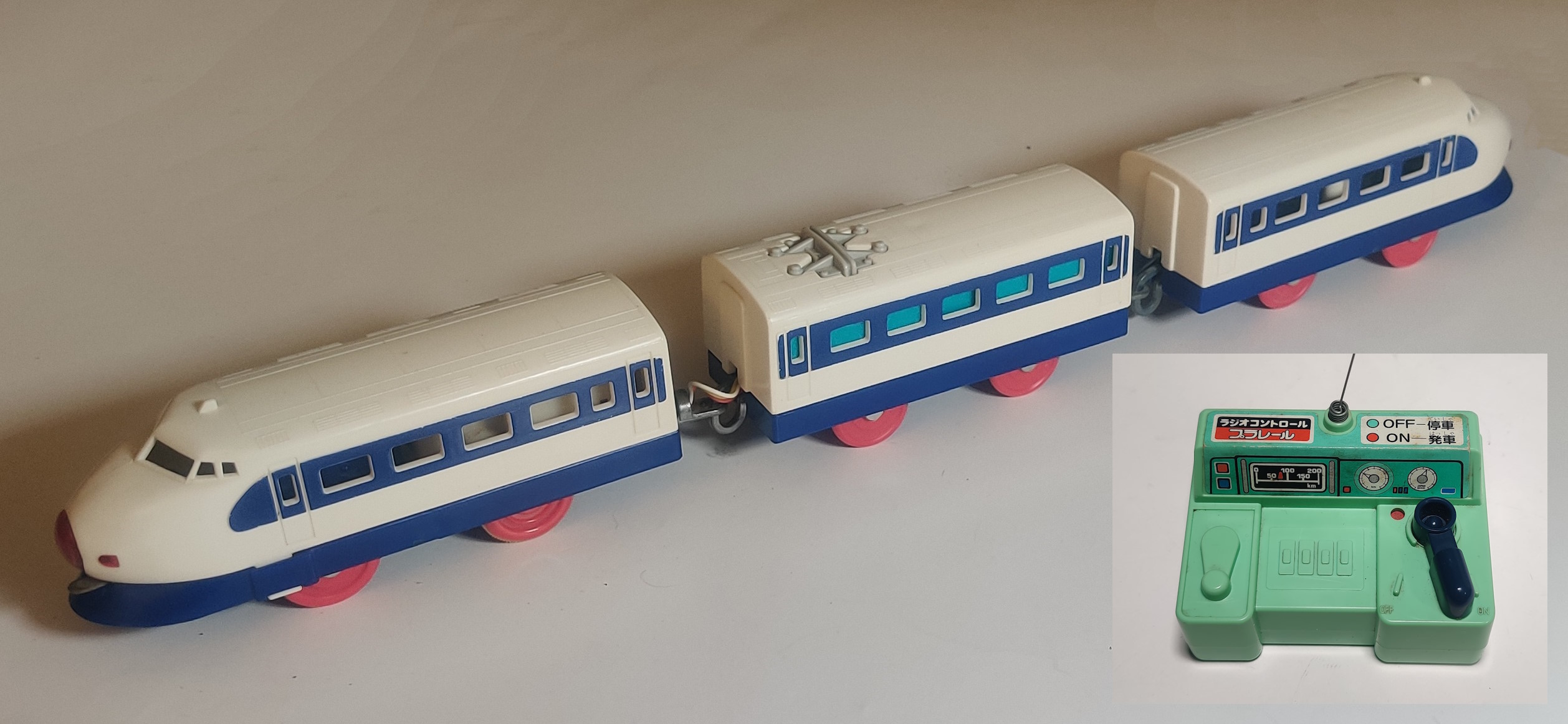
In 1984 the first series of remote control Plarail trains entitled ラジオコントロール ぼくはうんてんしゅ (roughly Radio Control: I'm A Train Driver) were released. The electronics and remotes for these trains were fairly simple and the only control available was "ON" or "OFF." Being from the mid 80s, the trains use the milky white plastic rim-drive gearbox.
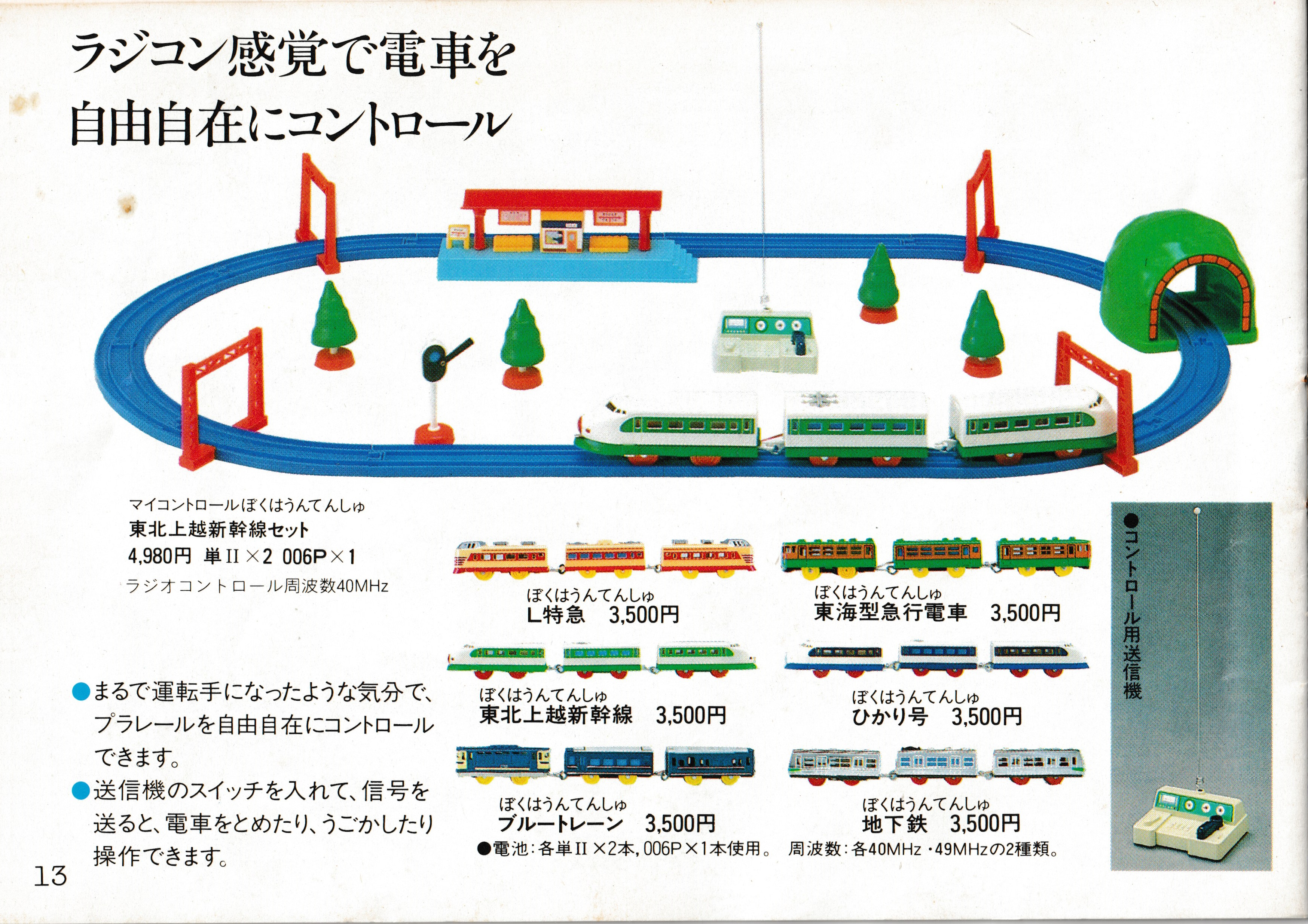
The Hikari 0 series Shinkansen, Tohoku Joetsu Shinkansen 200 series and Blue Train all appear in the first catalogue for 1984 from May with the Subway Train being added in the August catalogue and the L Limited Express and Tokai type Express Train appearing in the final October 1984 catalogue. Trains operated on either 40mhz or 49mhz bands and it seems all trains could be bought in both frequencies. These trains remained on sale until around 1987 when the new power gearbox was introduced but due to their high price they did not sell exceptionally well and contributed to the "winter era" of the early-mid 1980s.
Radio Control Hikari (Early 1984)
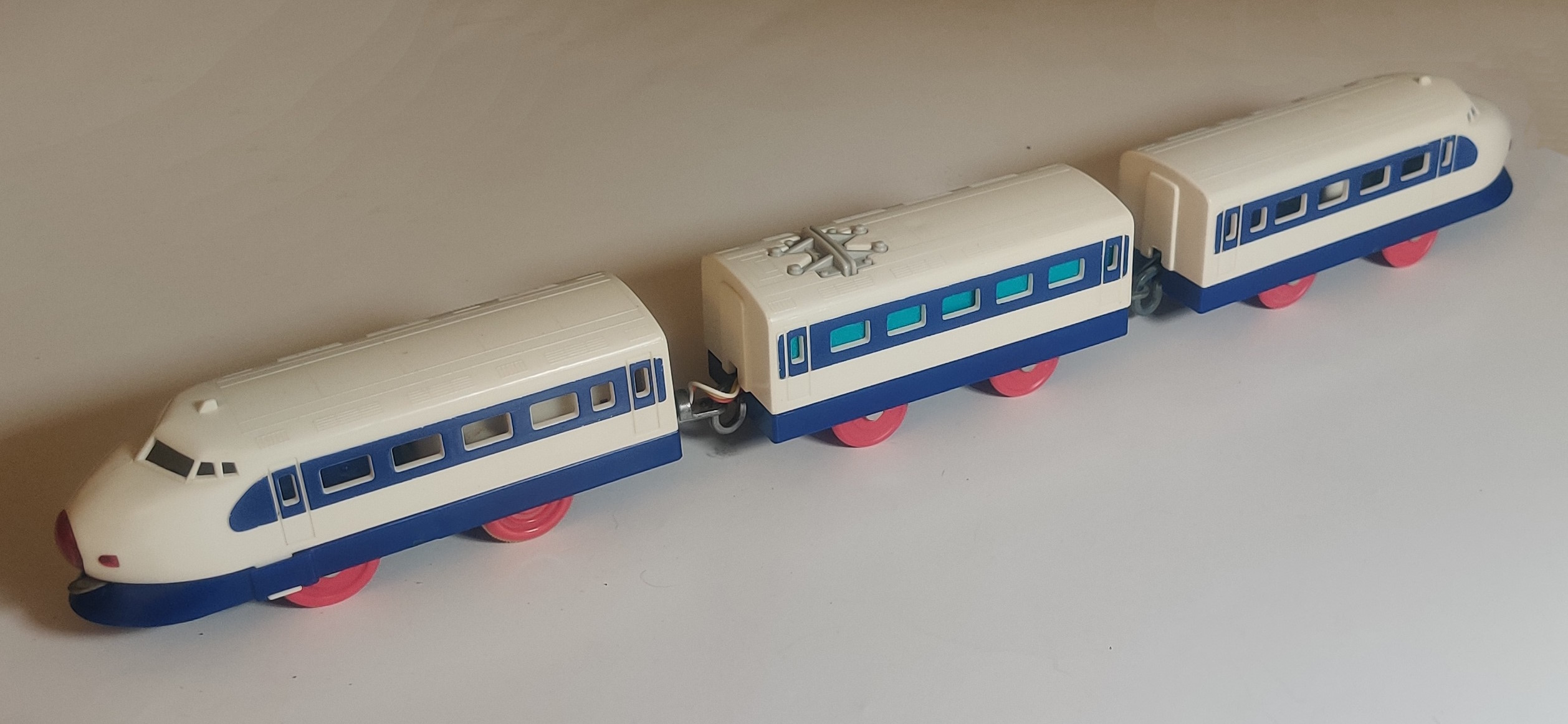
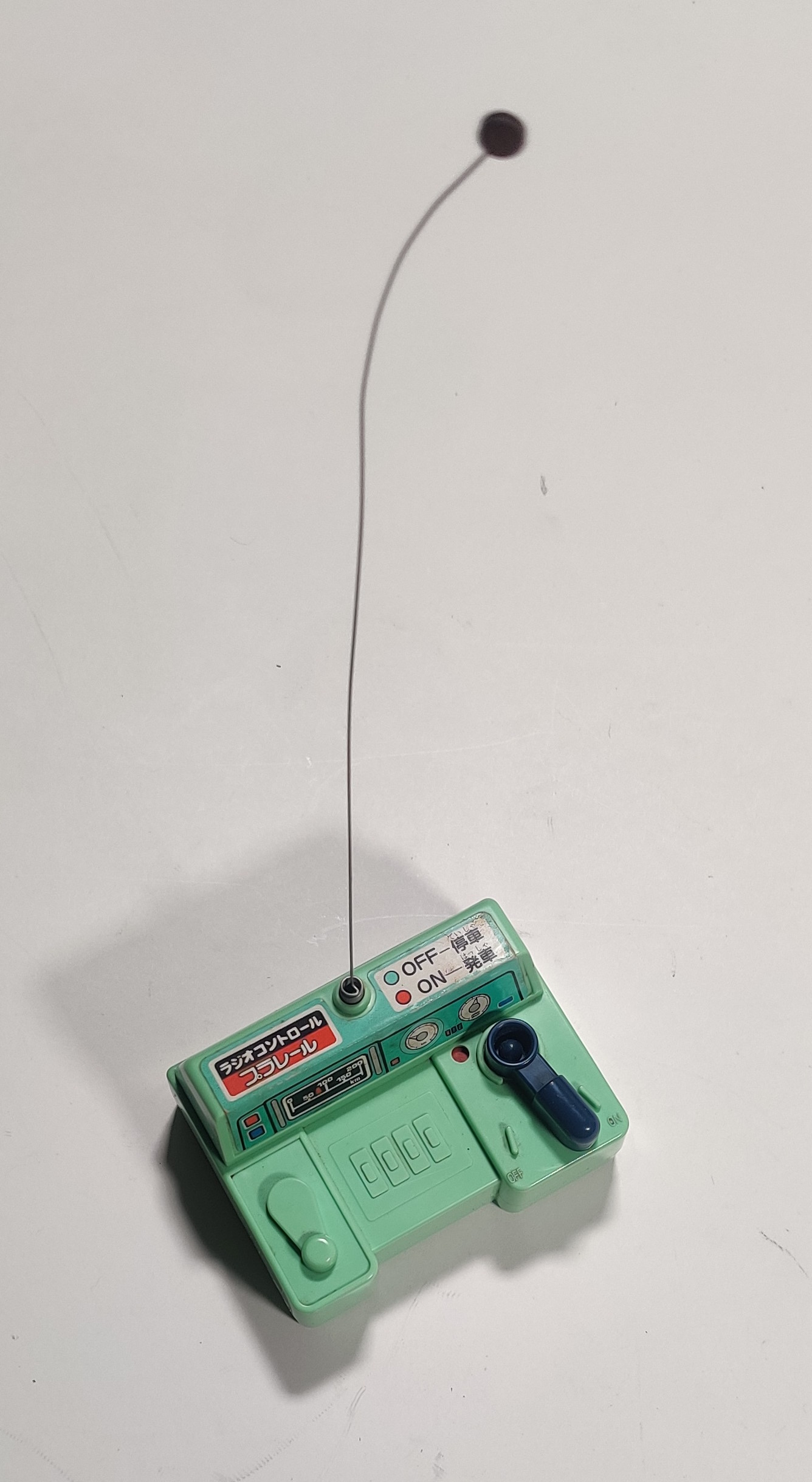
The Radio Control Hikari (ラジオコントロールひかり号) was based on the then-current molding for the Hikari with Light. The three-car train is semi-permanently coupled together with interlocking metal couplings in the place of the standard plastic hook and loop couplers.
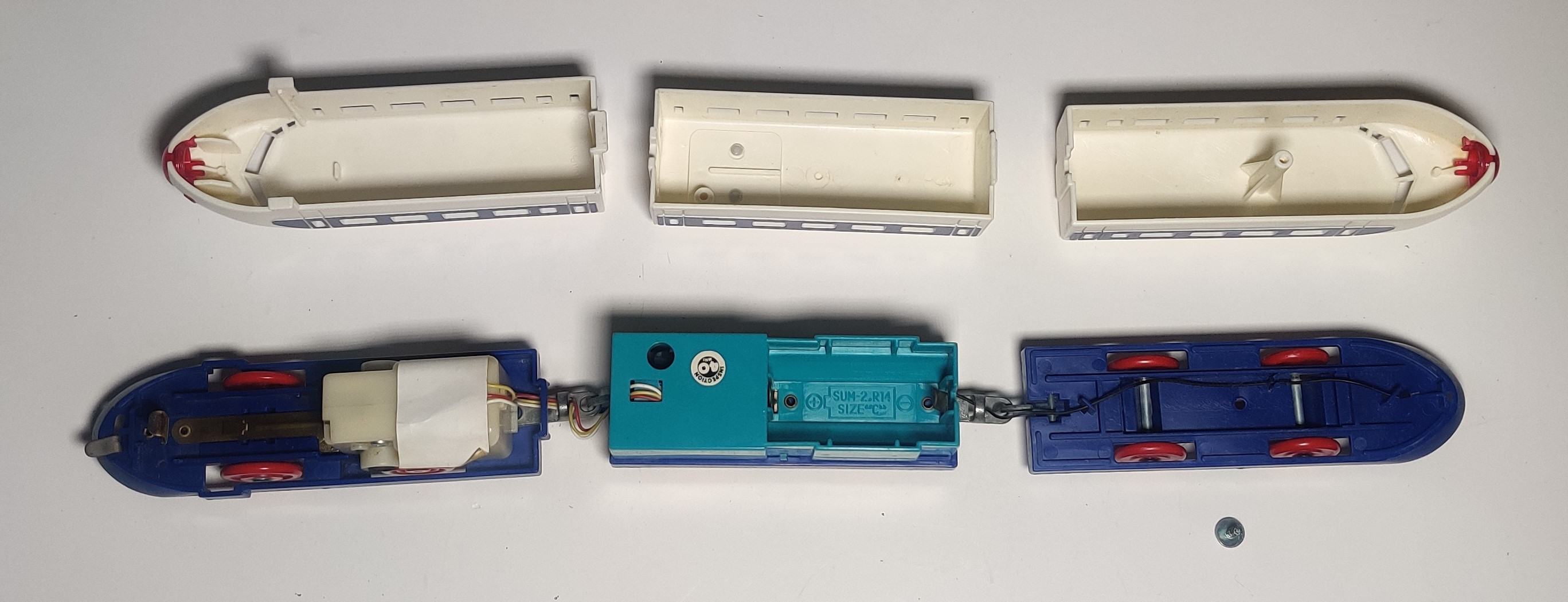
The front body shell lifts off like usual to accept one C battery. The lead car has a front mounted power switch and a slightly modified plastic rim-drive gearbox. The intermediate car shell is friction-fit around the housing for the control circuitry and second C battery. This oddly-colored housing has a sticker indicating its frequency and is clipped into a modified 0-series chassis. The top of the housing has a hole for an additional friction-fit interface with a cylindrical protrusion in the intermediate car shell roof. An antenna wire leads out into the tail car. After the discontinuation of the radio control series of trains, some molding characteristics such as the voids for the clips on the radio control housing in the intermediate car chassis and the protrusions in the tail car chassis to hold the antenna remained in the regular production Hikaris. More details about this can be found on the Hikari with Light page.
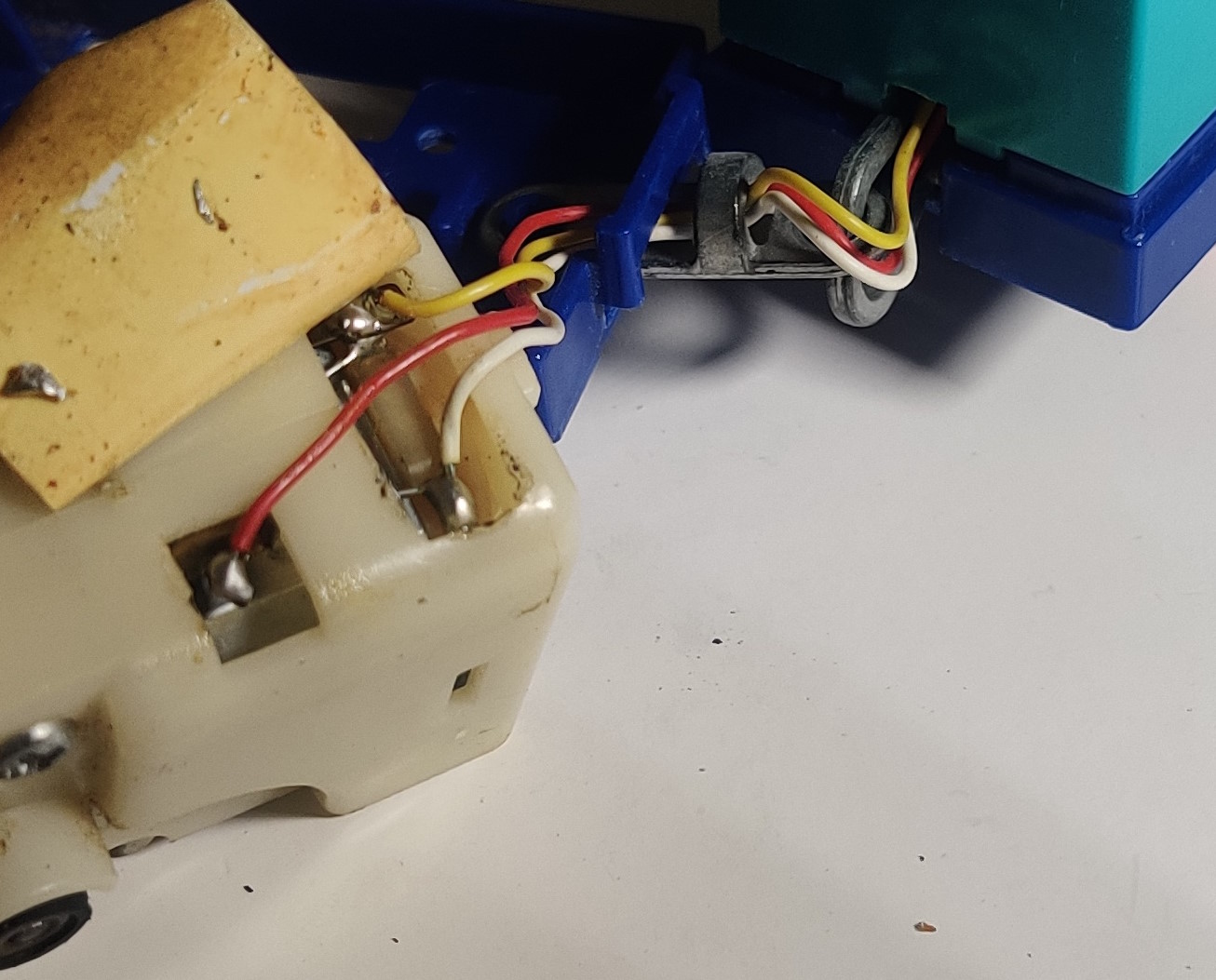
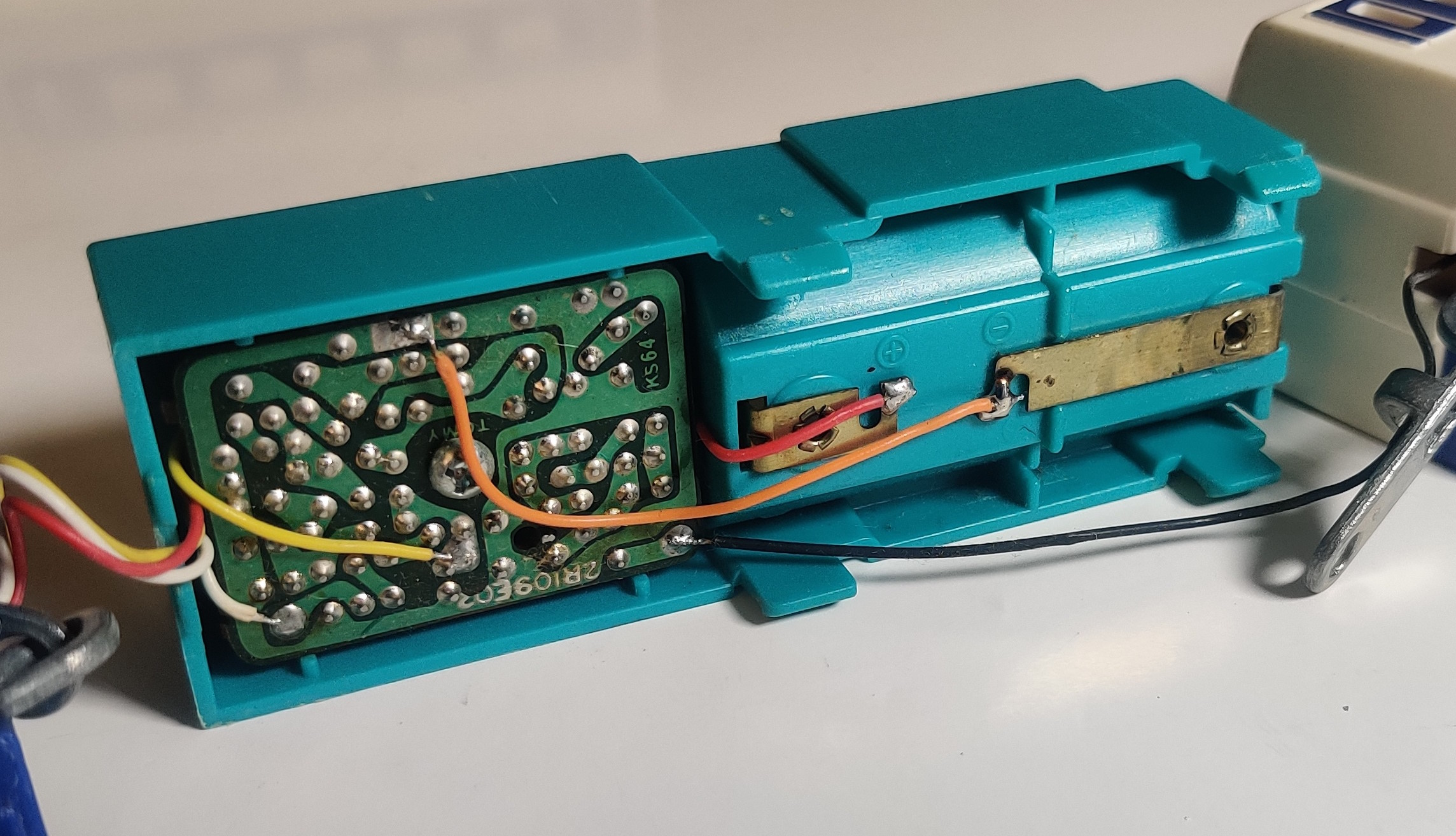
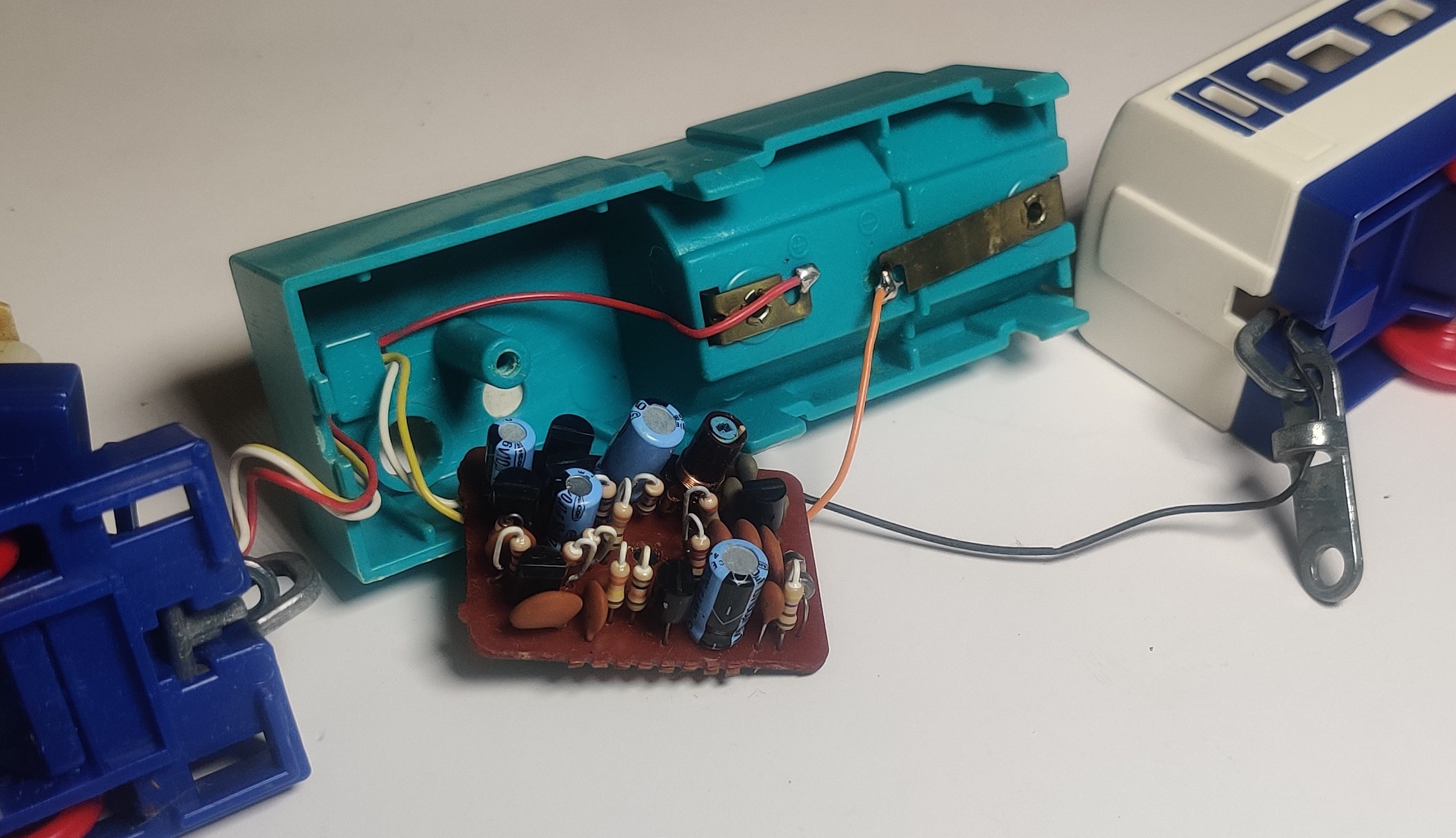
The gearbox has the regular positive battery contact on the front and engages underneath with the front negative contact strip, but the positive contact strip inside the gearbox is interrupted before reaching the motor and a wire instead sends the positive side of the battery to the remote control unit. Another wire returns to the positive contact of the motor and a third wire connects the unit to the negative side of the motor. This wiring allows the remote control unit to turn on and off power to the motor.
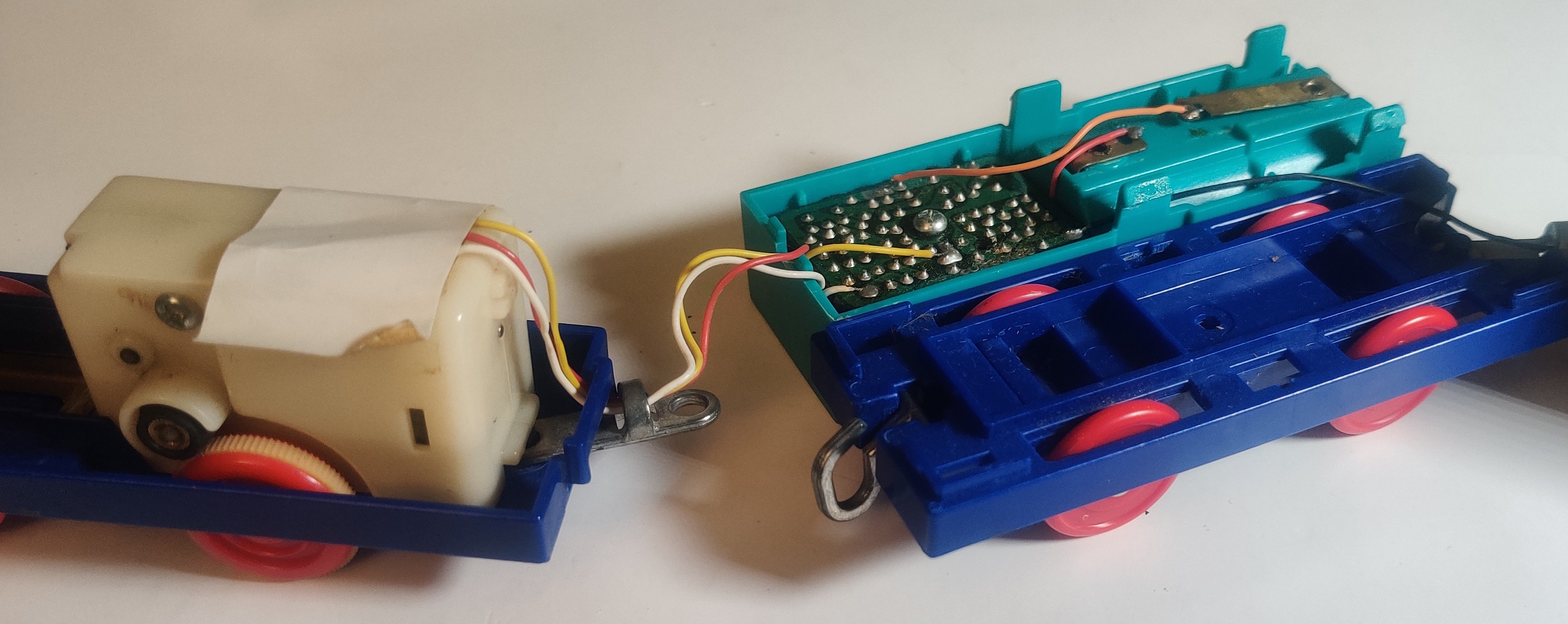
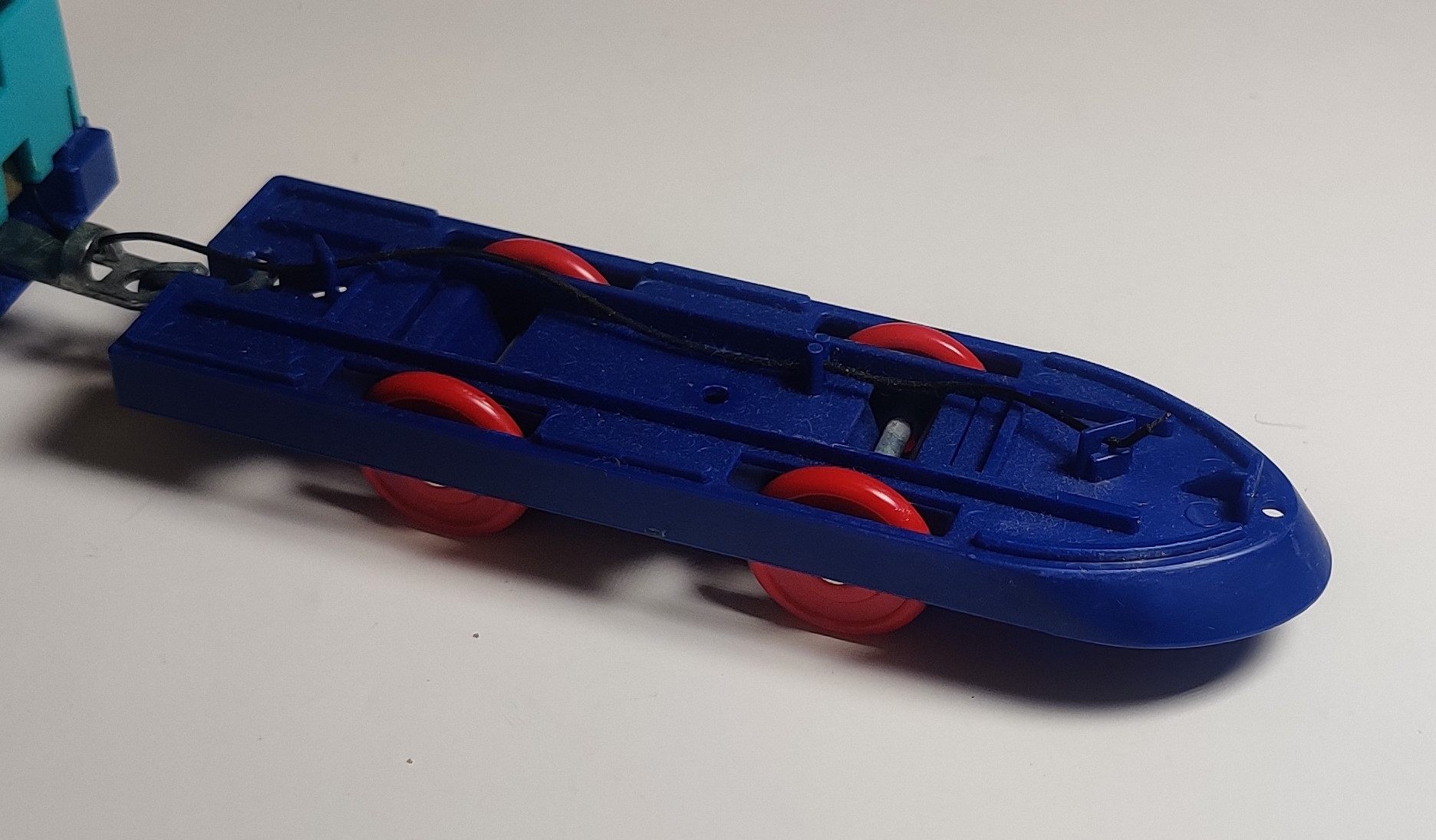
The couplings are completely made out of metal. The rear couplings have a loop for wire routing and the front couplings are bent back in on themselves so that when the car is assembled the loop can not be removed. This are probably the most robust Plarail couplings ever made, although they obviously do not come apart like regular plastic couplings. Compared to later solutions for connecting permanently coupled trains they are very sturdy, probably the best permanent couplings Tomy has ever made, although they do leave the wires exposed.

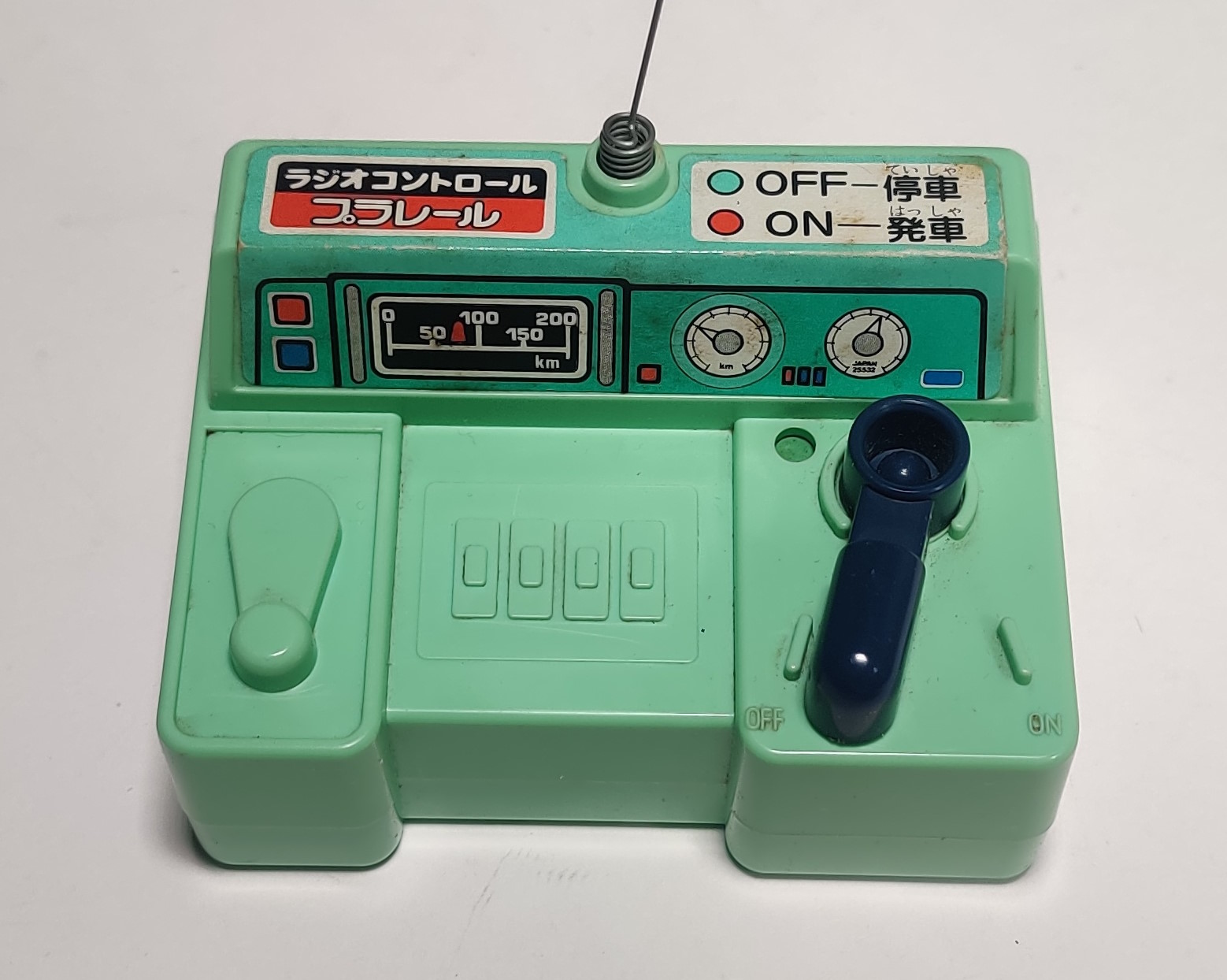
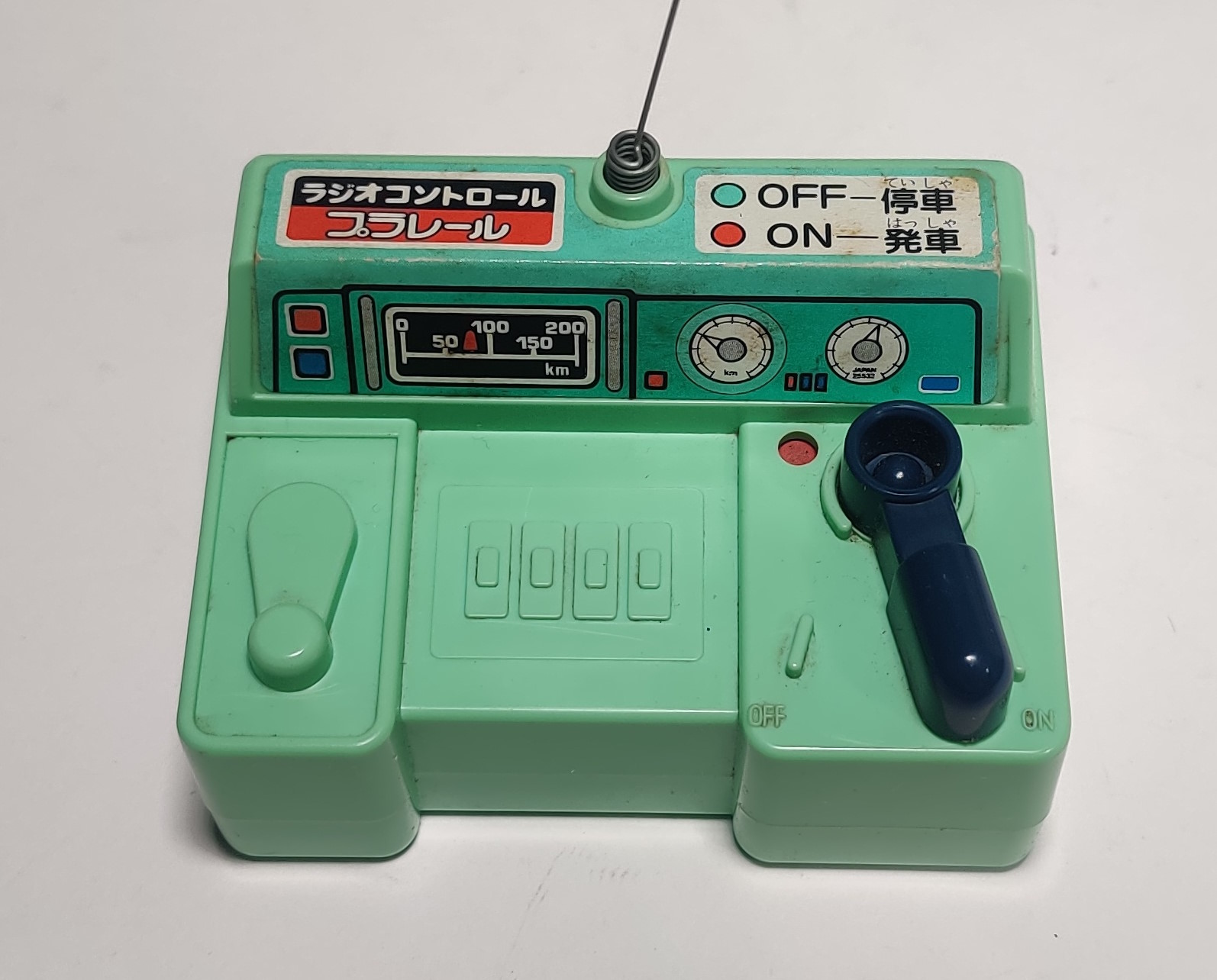
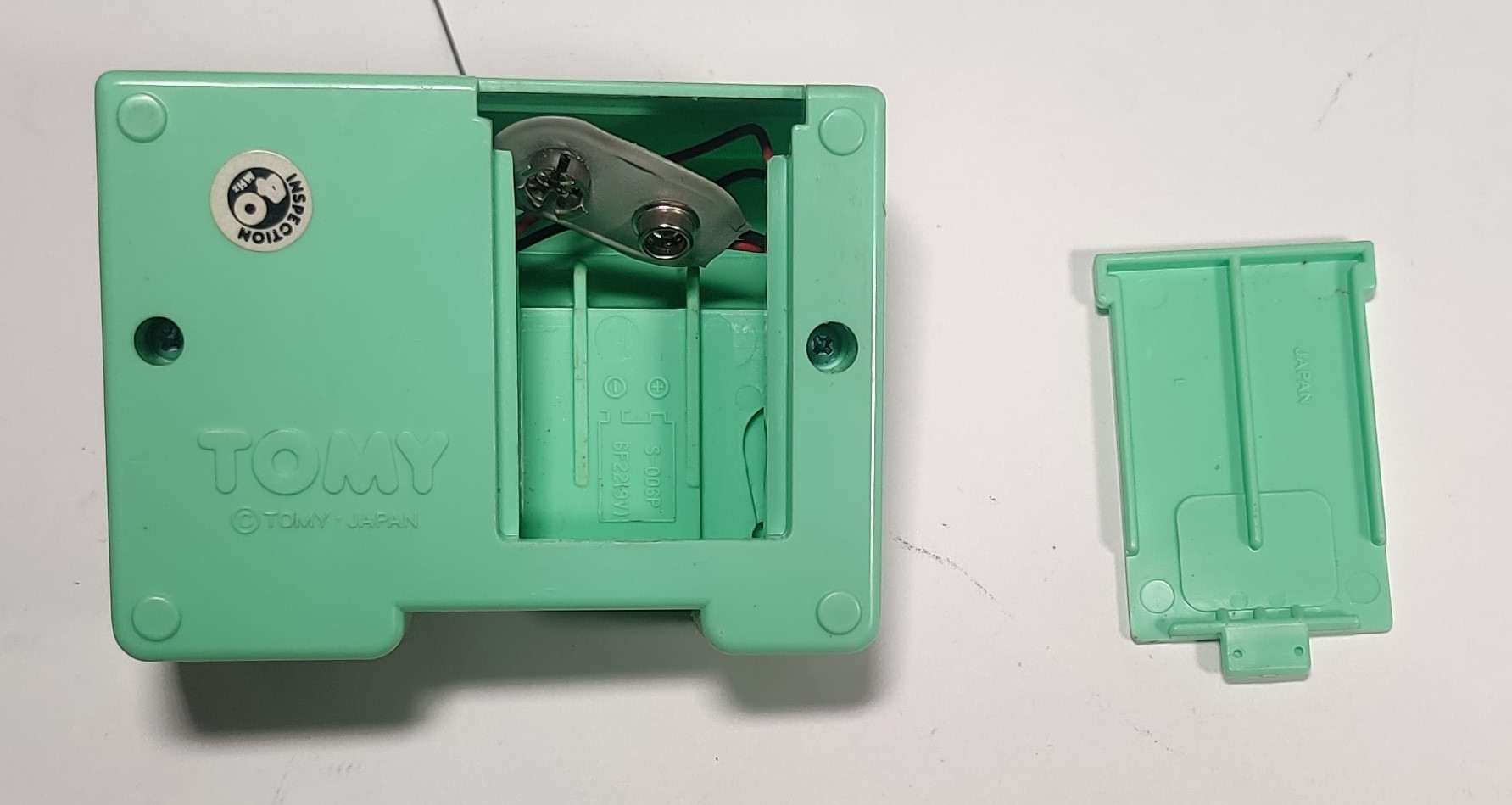
The remotes are fairly small and are a nice green with cool graphics. The remote is roughly molded after the shape of some locomotive control systems. The remote lever also slides a small colored indicator under a hole in the molding, green for off and red for on. The bottom of the remote is marked with a frequency sticker and has a slide-off cover for the 9-volt battery required for the remote.
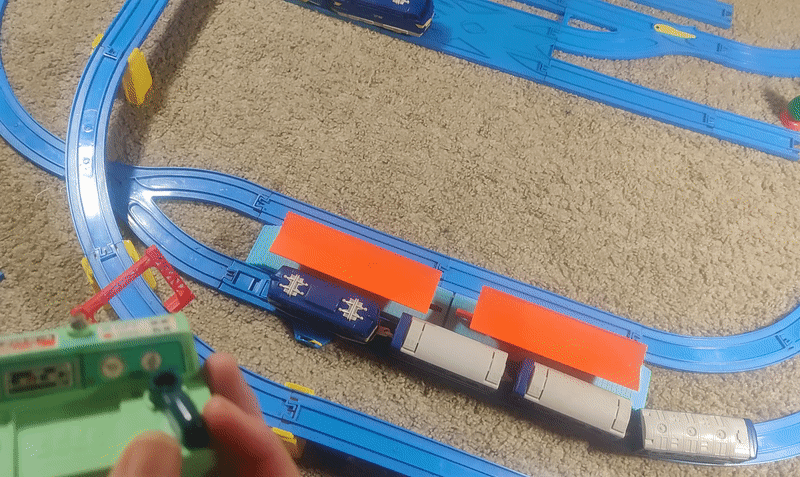

When I first received my radio control Hikari it was at the same time as a number of other 1980s Plarail trains, track, and accessories. I built a small layout incorporating many of the new pieces and ran the radio control Hikari on it. I am not sure what in my room is interfering on the 40mhz band but I found that the Hikari would often shudder forward slowly when the remote was switched to the "OFF" position.
Radio Control Tohoku Joetsu Shinkansen (Early 1984)
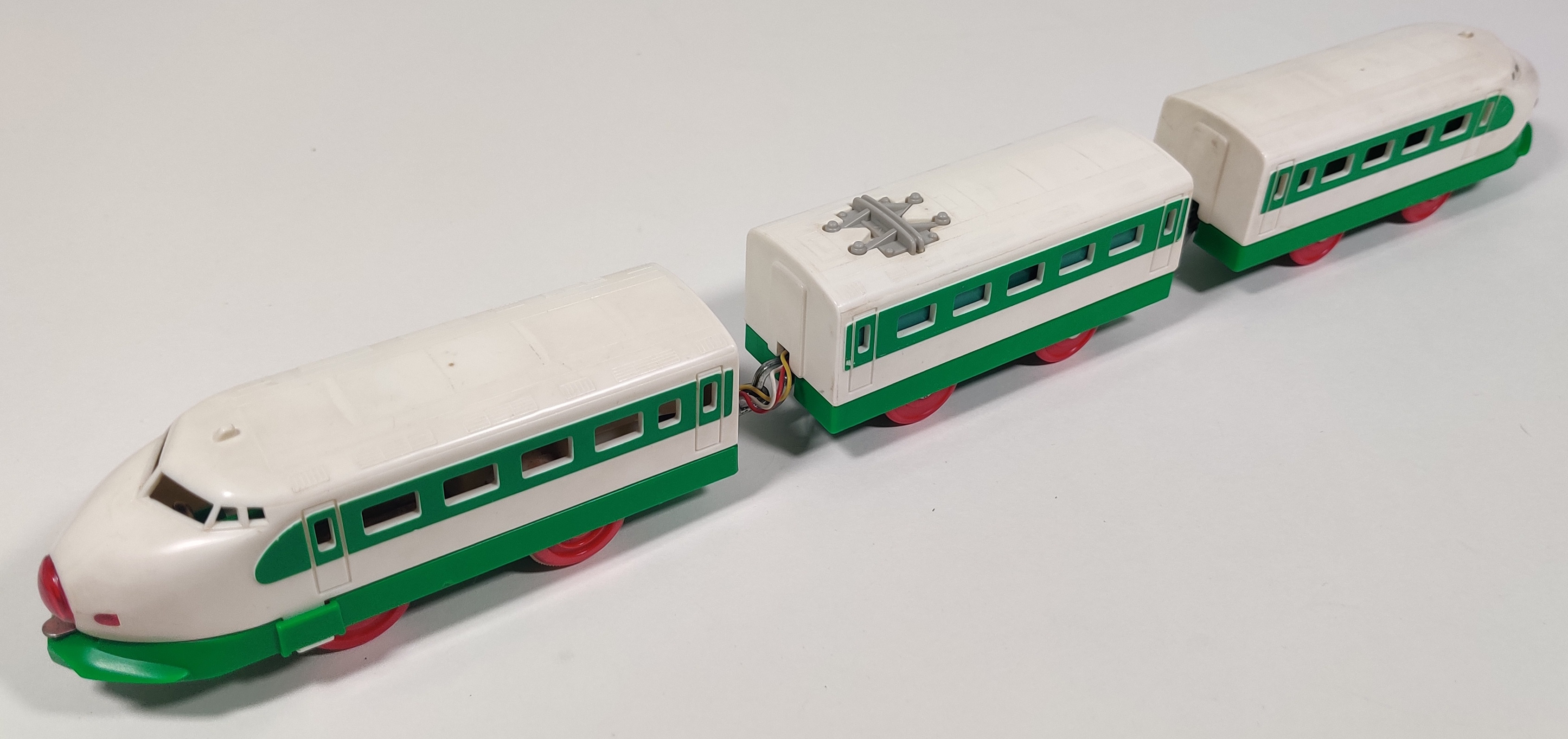
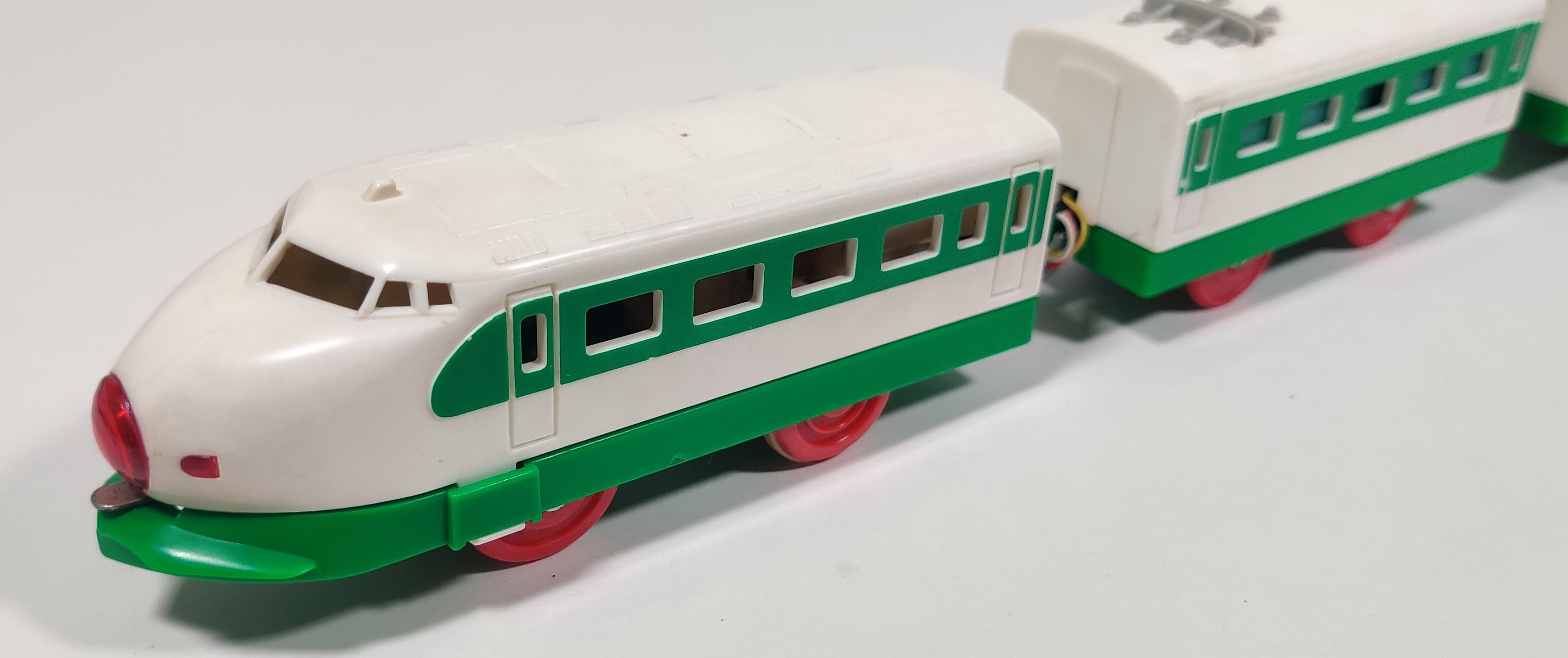

Also released in the initial wave of radio control engines as well as in the only set of the series, the Radio Control I'm a Driver Tohoko Joetsu Shinkansen Set, the 200 series Shinkansen was also represented in the series and looks very nice and more or less identical externally to the period Tohoku Joetsu Shinkansen with Light.
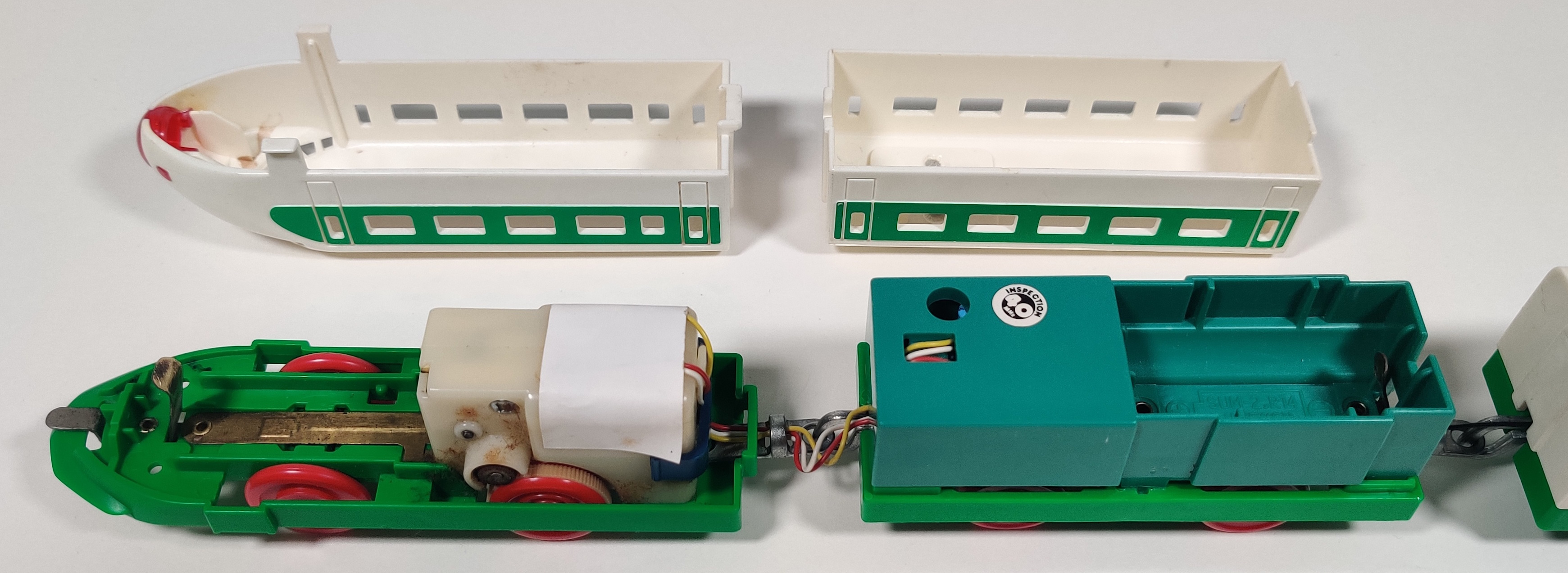
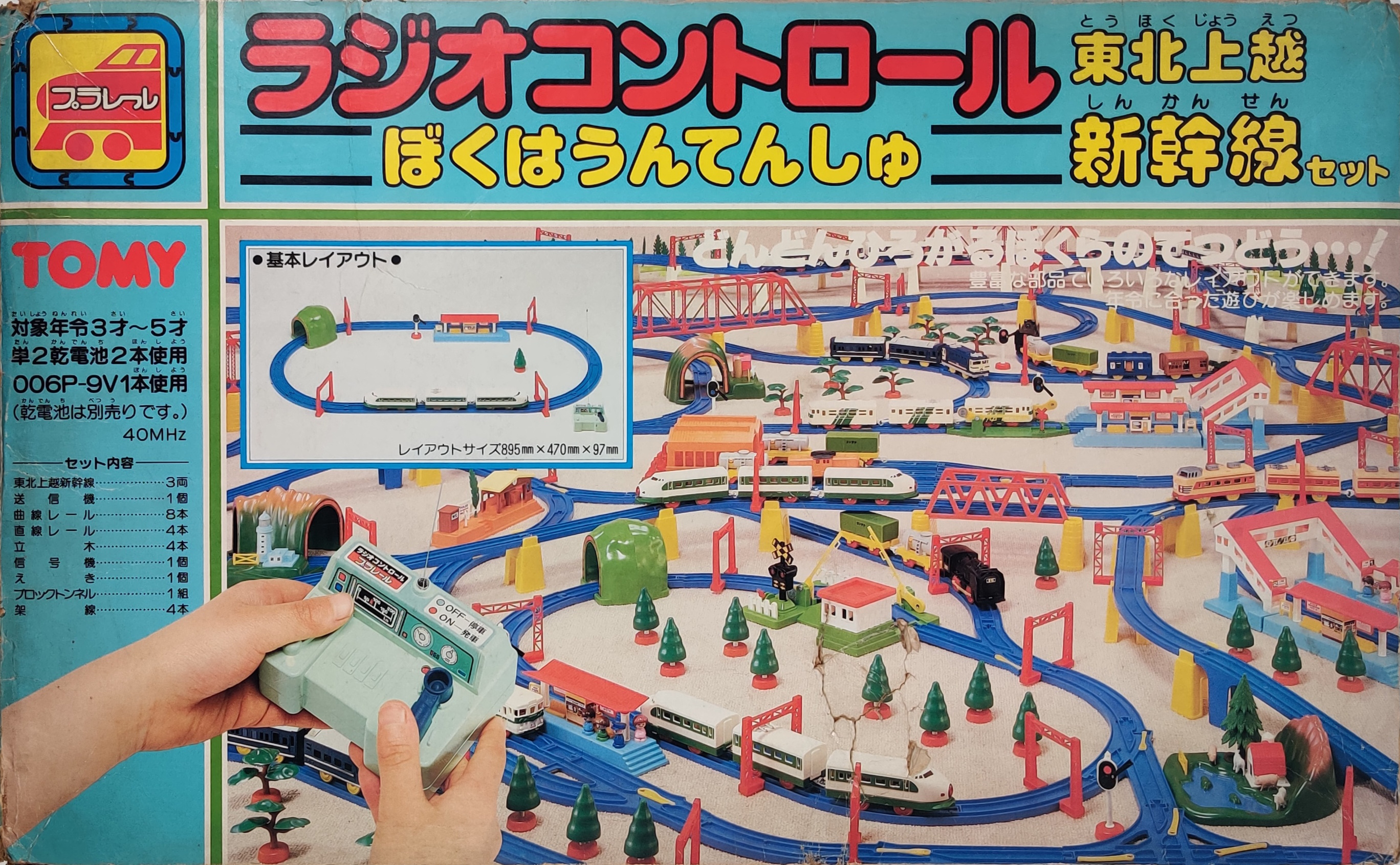
This example comes from a copy of the Radio Control I'm a Driver Tohoko Joetsu Shinkansen Set and is a 40Mhz model. The set included a second 40Mhz remote, although this one was missing its battery cover.


You can see underneath where the tooling was adapted from the lit version of the chassis. The intermediate and tail car toolings were used for some of the later production 200 series trains.

Radio Control Blue Train (Early 1984)
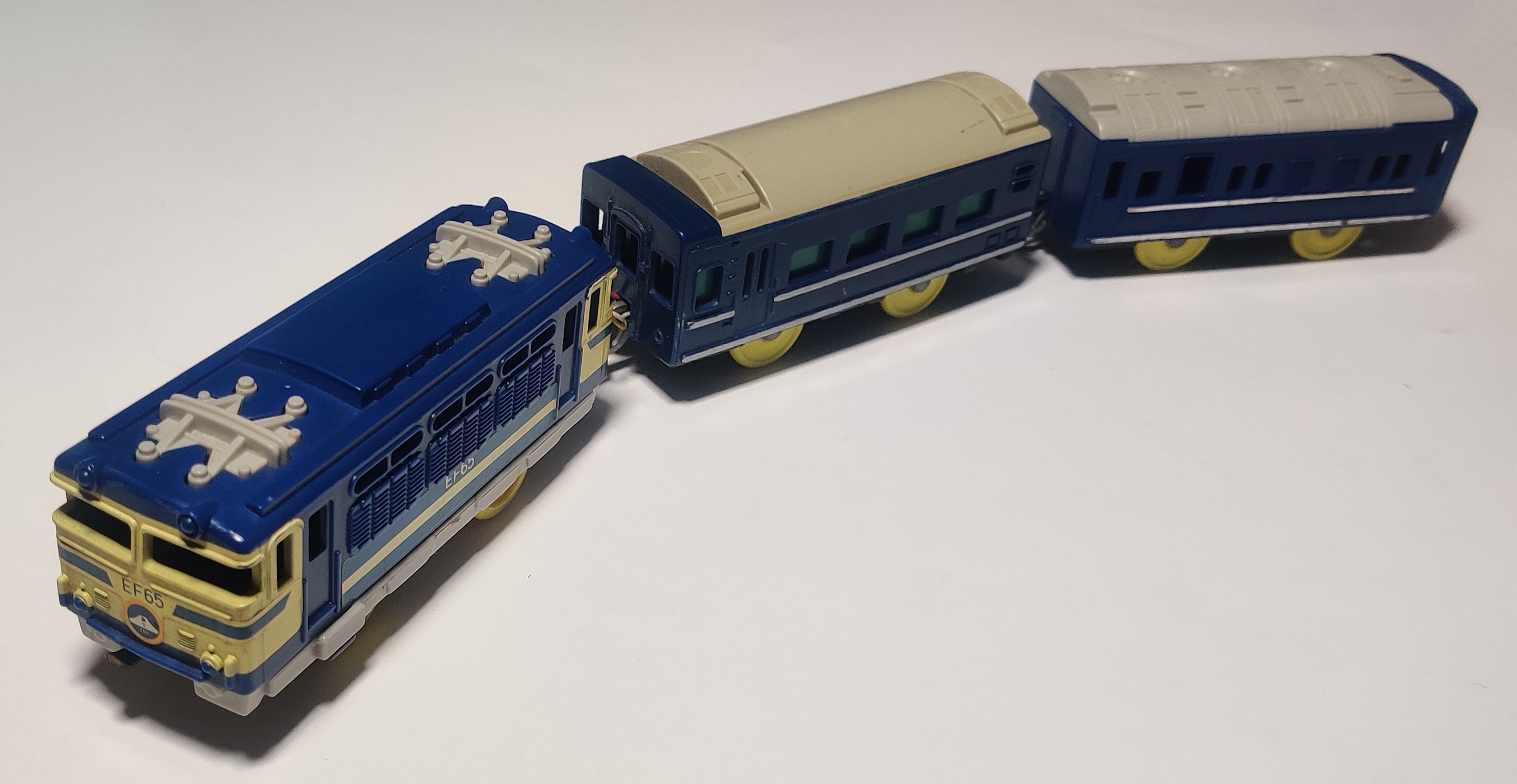
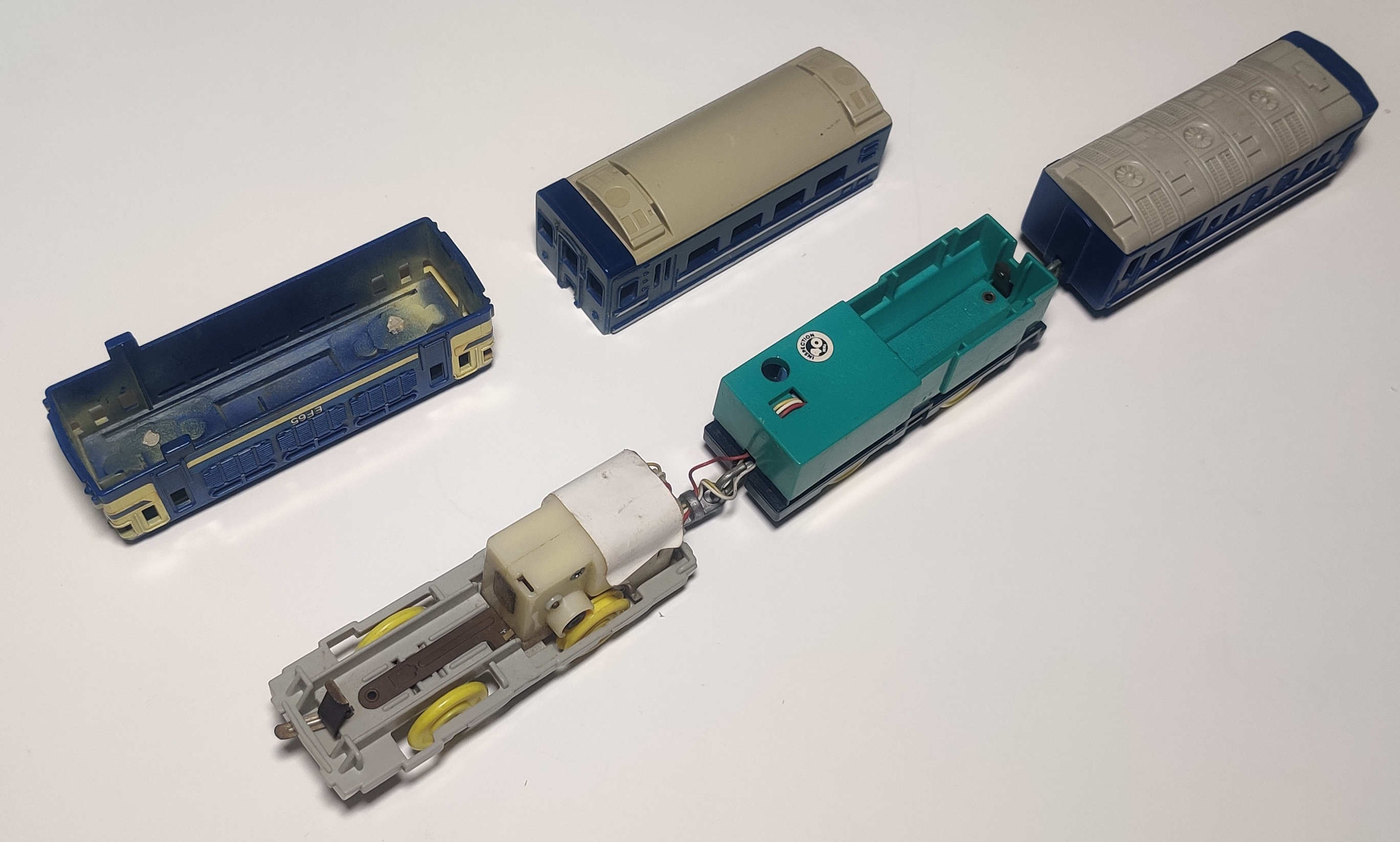
Also part of the initial three radio control trains was the EF65-powered Blue Train with 24 series passenger cars.
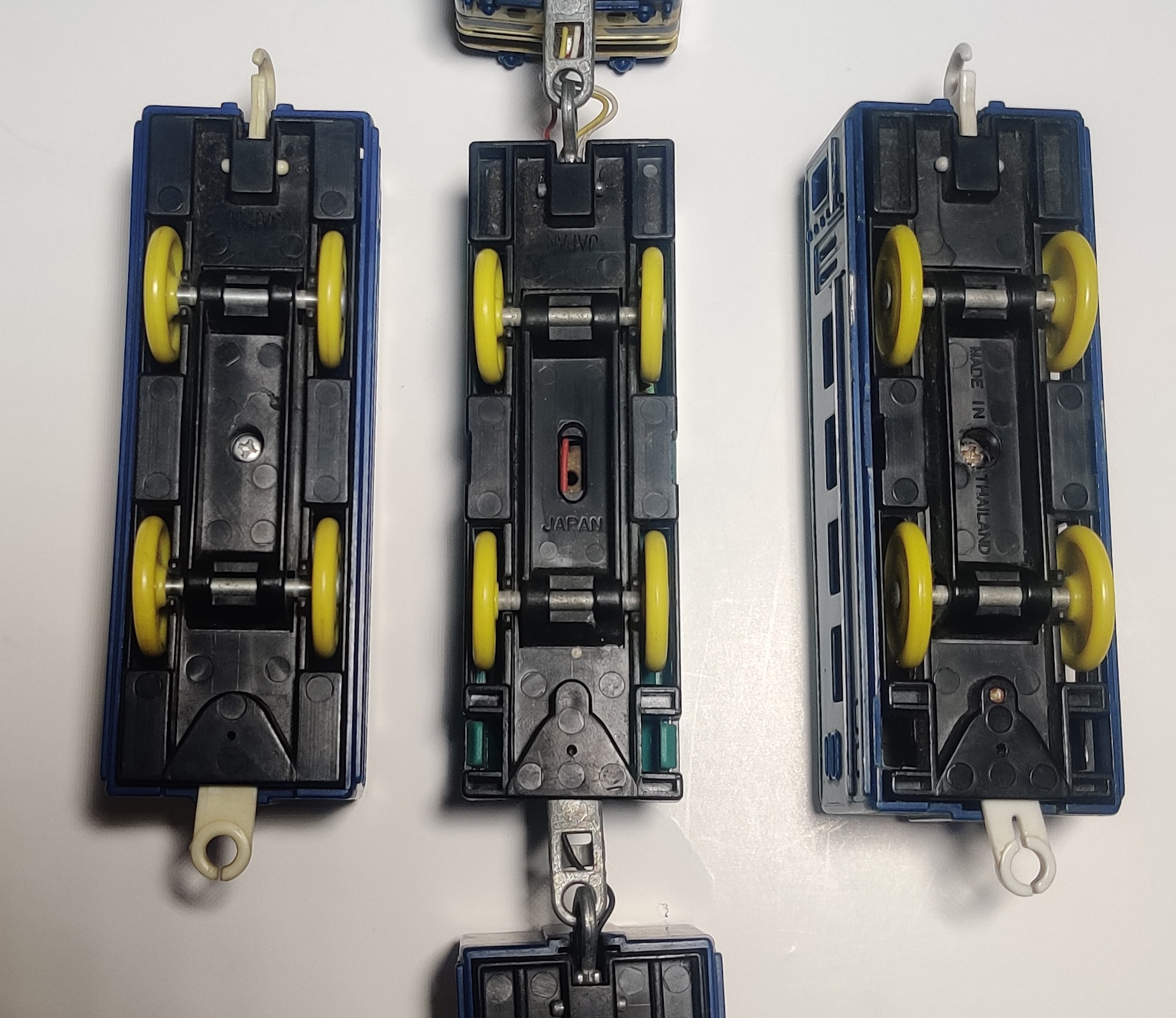
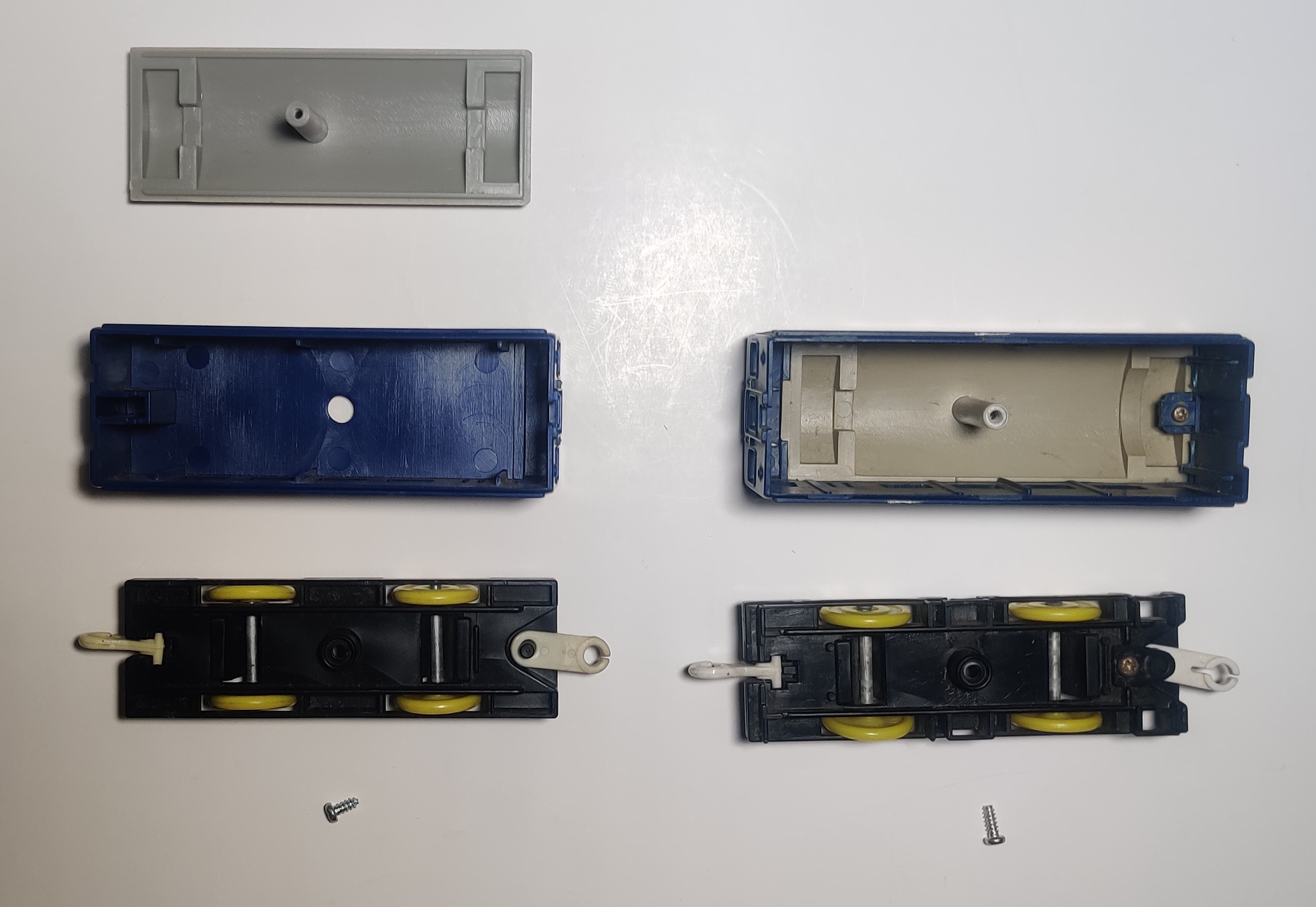
Like the other trains, the intermediate and tail car toolings were updated to accommodate the radio control receiver - the intermediate car roof was fastened to the car body instead of simply sandwiching the body shell down to the chassis so that the friction-fit lift-off radio control version of the intermediate car would work properly. This change was carried forward to later Blue Trains.
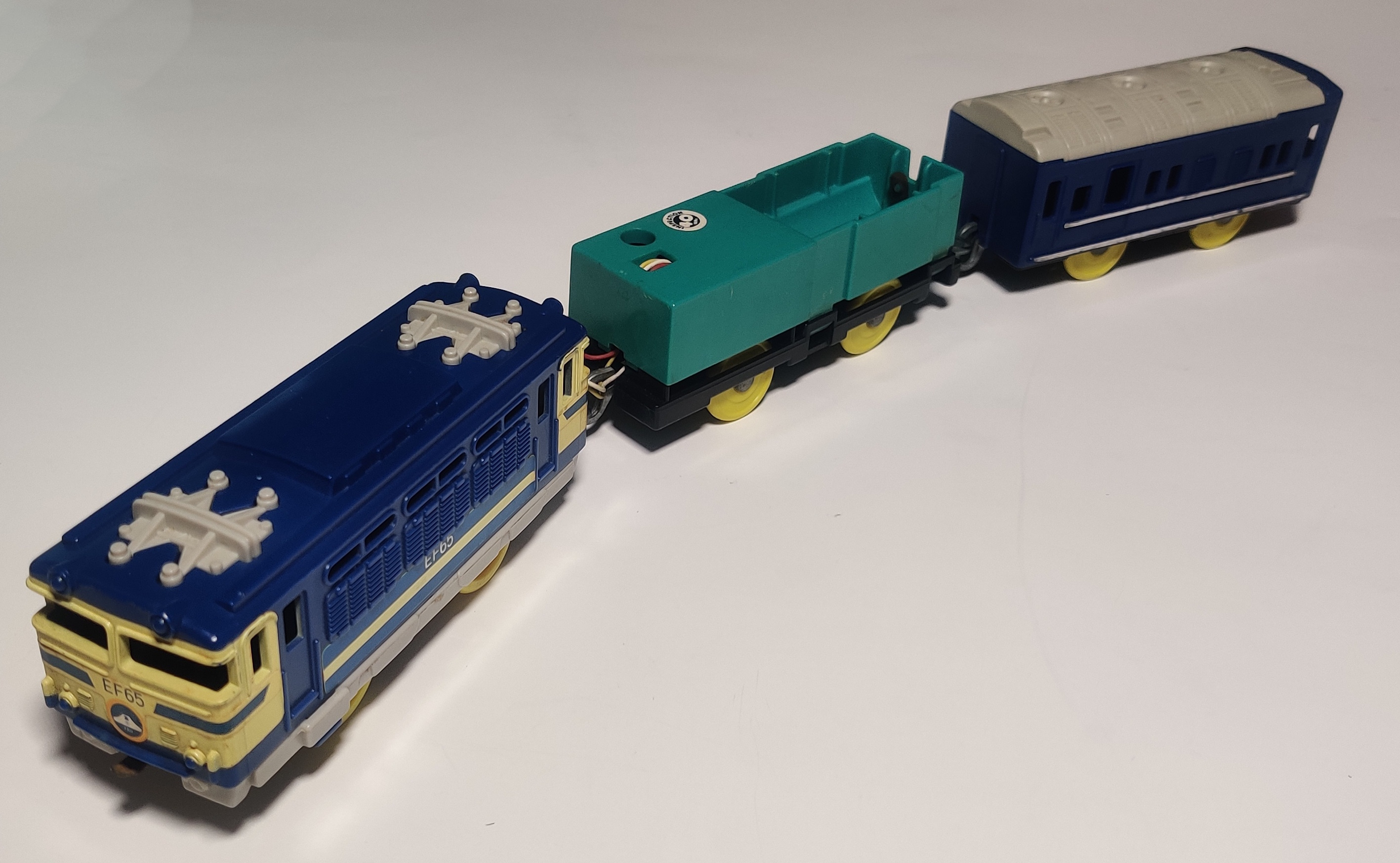

This radio control Blue Train was purchased in a lot of junk Plarail and it did not have the EF65 shell or intermediate car. Luckily, it is a 40mhz model so it works with the remotes from the other trains (and seems to pick up even more interference). At the same time (but from a different auction) I ended up with an old power EF65 body shell but I do not have an original intermediate car with no screw support - the "best" substitute would, I suppose, be a Japan-produced Blue Train intermediate car from between 1984 and 1987 when the tooling was updated but still produced in Japan. It is pictured above with the top shell from a Thailand-made intermediate car with the regular screw post intact and sitting in the empty C battery compartment. I could cut the screw stem off of this Thailand coach or the 80s Japan-made intermediate car I have with a mid 80s Blue Train but I would rather wait until I come across a second example of either of these compatible coaches before I cut the only example of them I currently have. It is not really that big a deal in the grand scheme of things, but getting any of this stuff in the United States is kind of hard and annoying (and usually pretty expensive) so I am fine with waiting and preserving my existing examples of variations.